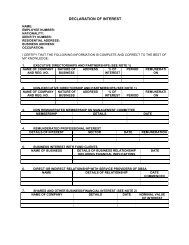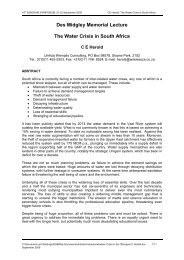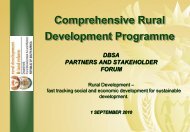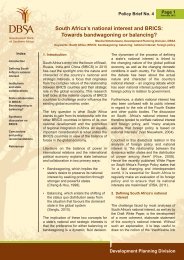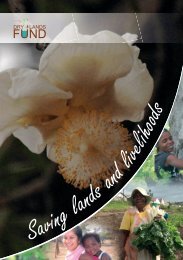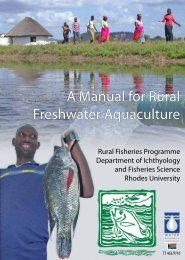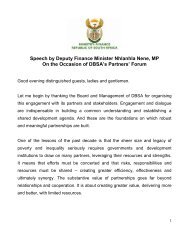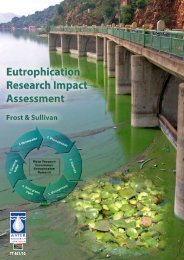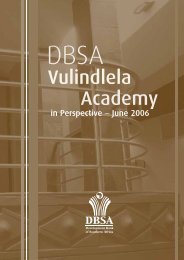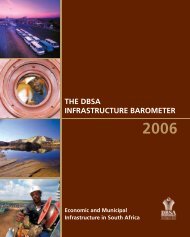ANNUAL REPORTS
ANNUAL REPORTS
ANNUAL REPORTS
Create successful ePaper yourself
Turn your PDF publications into a flip-book with our unique Google optimized e-Paper software.
Operations overview - South Africa Operations continued<br />
Operations results<br />
South Africa Operations portfolio, 31 March 2011<br />
25<br />
20<br />
15<br />
10<br />
5<br />
0<br />
31 March 2010<br />
Preparation<br />
Negotiation<br />
Implementation<br />
Completed<br />
31 March 2011<br />
R billion<br />
Some of the specific highlights are discussed in more<br />
detail below.<br />
• Investment focus on infrastructure categories<br />
and sectors<br />
The Division sought to balance its support for the different<br />
categories of infrastructure in order to maximise the<br />
development impact of its investment. The multi-sectoral<br />
nature of development requires that investments in social<br />
infrastructure be supported by corresponding investments in<br />
bulk enabling infrastructure and in the development of energy,<br />
water and road networks. Such investments should also be<br />
aligned with those that build the economic sustainability of<br />
an area. The figures below show the percentage value of<br />
disbursements for 2010/11 by client and by sector.<br />
Disbursements by type of client, 2010/11<br />
Loan book Pipeline Loan book<br />
Not disbursed<br />
Disbursed<br />
By the end of 2010/11, the Division’s loan portfolio had<br />
grown to a book debt of R22,7 billion (2009/10: R20,9 billion),<br />
an increase of 8,6%.<br />
The divisional pipeline of new projects was low at the start<br />
of the year, following the high levels of implementation and<br />
disbursements achieved in 2009/10. The Division continued<br />
with normal operations, providing funding to municipalities<br />
mainly through open tenders, but also broadened its<br />
value offerings and client base, and delivered investment<br />
support through technical and financial instruments. Initially,<br />
upward pricing pressures resulted in a low conversion of<br />
approvals to commitments for the highly contested top 40<br />
municipalities that went to market. Nevertheless, significant<br />
progress was made in developing sustainable solutions for<br />
provincial and under-resourced municipal clients.<br />
Metropolitan municipalities 17,6%<br />
Secondary municipalities 29,1%<br />
Under-resourced municipalities 7,5%<br />
Education 11,3%<br />
Non-municipal clients 34,5%<br />
Disbursements per sector, 2010/11<br />
44<br />
The implementation of these strategies generated a pipeline<br />
of over R12,1 billion, which will form the basis of increased<br />
investment levels from 2011/12. The state of the portfolio<br />
per phase of the project cycle is reflected in the figure above:<br />
despite a challenging environment, the total asset base grew<br />
by 9% year-on-year. At year-end, projects in implementation<br />
stood at R4,9 billion, with a further R8,4 billion in various<br />
stages of preparation and appraisal.<br />
The achievements recorded here were made possible<br />
by increased approvals, amounting to R11,3 billion, to a<br />
diversified client base. As most of the approved projects<br />
have a long preparation and lead time, disbursements were<br />
generally low; only R3,1 billion was disbursed over this period.<br />
Still, positive results, such as the reduction of the default<br />
rate noted above, were realised despite difficult economic<br />
conditions.<br />
Social infrastructure 2%<br />
Energy 36%<br />
Transportation 33%<br />
Education 11%<br />
Water 8%<br />
Roads and drainage 6%<br />
Sanitation 4%<br />
DBSA | <strong>ANNUAL</strong> REPORT 2010/11



